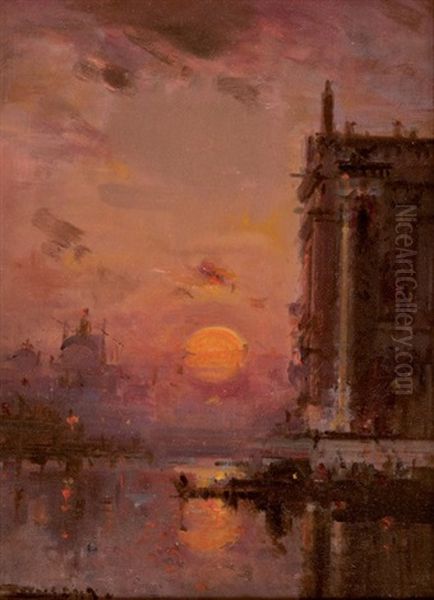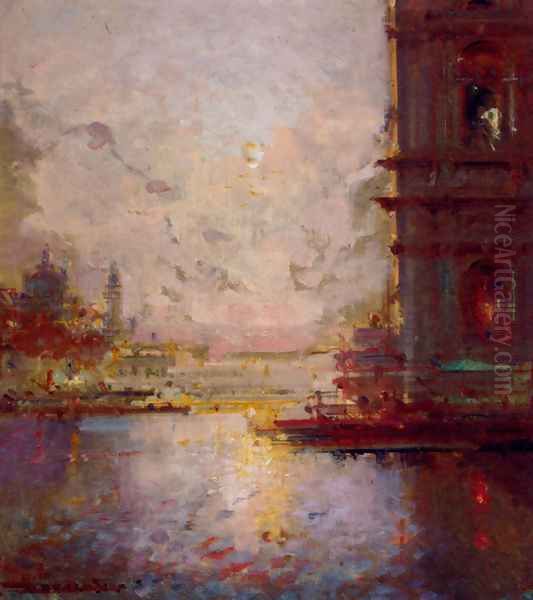Henri Duvieux stands as a notable figure among the French Orientalist painters of the late 19th century. Born in Paris in 1855 and passing away in 1920, his artistic career unfolded during a period of immense change and dynamism in the European art world. Duvieux carved a distinct niche for himself, specializing primarily in evocative cityscapes, particularly those of Venice and Constantinople (modern-day Istanbul). His work is characterized by a fascination with light and atmosphere, skillfully blending elements of traditional marine and landscape painting with the burgeoning sensibilities of modern art, including touches of Impressionism.
Early Life and Artistic Formation
Born into the vibrant artistic heart of France, Paris provided the backdrop for Duvieux's early life and initial artistic inclinations. While specific details about his childhood remain relatively scarce, it is known that he pursued formal artistic training. He became a pupil of Prosper Marilhat (1811-1847), an earlier French painter who himself was renowned for his Orientalist scenes, particularly those inspired by his travels in the Near East. Although Marilhat passed away before Duvieux could have studied with him extensively in his prime, the influence of Marilhat's style and subject matter likely resonated with the young artist, perhaps through posthumous reputation or instruction from Marilhat's followers.
Duvieux emerged as an artist during a time when the Paris Salon was the preeminent venue for artists to gain recognition and patronage. He made his official debut at the Salon in 1880, presenting views of both Venice and Constantinople. This initial showing set the stage for his career, establishing his primary subjects and signaling his interest in capturing the unique character and visual splendor of these iconic cities. The late 19th century also saw the rise of Impressionism, spearheaded by artists like Claude Monet, Pierre-Auguste Renoir, and Camille Pissarro, who revolutionized the depiction of light and contemporary life. While Duvieux was not strictly an Impressionist, their focus on atmospheric effects undoubtedly informed his own artistic vision.
The Allure of the Orient and the Venetian Exception

Orientalism, as an artistic movement, reflected a widespread European fascination with the cultures, landscapes, and peoples of North Africa, the Middle East, and Asia. Artists sought exotic subjects, vibrant colors, and dramatic light effects often perceived as lacking in European settings. Pioneers like Eugène Delacroix had paved the way earlier in the century with his dramatic depictions inspired by his travels. Duvieux clearly operated within this tradition, drawn to the architectural grandeur and bustling life of Constantinople, a true gateway between Europe and Asia.
Interestingly, Venice, although geographically European, frequently featured in the Orientalist repertoire. Its historical position as a maritime republic with extensive trade links to the East, its unique blend of Byzantine and Gothic architecture, and its labyrinthine waterways imbued it with an exoticism that appealed to artists seeking picturesque and atmospheric subjects. Duvieux became particularly adept at capturing the distinct moods of Venice, rivaling other contemporaries who were also captivated by the city.
Venice Through Duvieux's Eyes
Venice became one of Duvieux's most enduring subjects. He returned to its canals, palaces, and squares repeatedly in his work, exploring the city under varying conditions of light and weather. His Venetian paintings often focus on the interplay of water and architecture, capturing the shimmering reflections and the grandeur of landmarks lining the canals. He possessed a keen eye for architectural detail, rendering the intricate facades of palazzos and churches with accuracy, yet he avoided dry topographical representation.
His primary concern was often the overall atmosphere – the hazy light of dawn, the golden glow of sunset, or the bright clarity of a sunny afternoon. Works such as La Grand Canal de Venise (The Grand Canal, Venice) showcase his ability to handle complex perspectives and bustling canal life, often featuring the characteristic gondolas that are synonymous with the city. Coucher de Soleil a Venise (Sunset in Venice) and Venise soleil couchant (Venice Sunset) highlight his skill in depicting the dramatic effects of twilight, bathing the familiar architecture in warm, evocative hues.

Another notable work, Panorama avec Voiliers et Gondoles a Venise (Panorama with Sailboats and Gondolas in Venice), demonstrates his ability to create expansive views, capturing the breadth of the Venetian lagoon and its maritime activity. While artists like Canaletto and Francesco Guardi had set the standard for Venetian view painting (vedute) in the 18th century, Duvieux brought a 19th-century sensibility to the subject, infusing his scenes with a more personal, often romanticized, response to the city's unique charm. He shares this fascination with other 19th-century painters like Félix Ziem, who also specialized in luminous Venetian scenes, and even J.M.W. Turner, whose earlier, more abstract visions of Venice emphasized atmosphere over precise detail. Claude Monet would later also famously paint the city, focusing intensely on light effects.
Constantinople: Gateway to the East
Constantinople offered Duvieux a different, yet equally compelling, set of visual motifs. As the capital of the Ottoman Empire, it represented the heart of the 'Orient' for many Europeans. Duvieux's paintings of the city often capture views across the Golden Horn or the Bosphorus, featuring the distinctive skyline punctuated by domes and minarets. He was drawn to the vibrant activity of the waterways, depicting traditional sailing vessels alongside the imposing forms of mosques and palaces.
In Vue de Constantinople au Couchant du Soleil (View of Constantinople at Sunset), Duvieux applies his characteristic sensitivity to light, capturing the city bathed in the warm colors of the setting sun. These works convey a sense of exotic grandeur and historical weight. His depictions aimed to transport the viewer, offering a glimpse into a world perceived as vastly different from Western Europe. He joined a lineage of artists captivated by the city, including Italian painter Alberto Pasini, known for his detailed and colorful scenes of Ottoman life and architecture, and the highly successful French academic painter Jean-Léon Gérôme, whose meticulously rendered Orientalist scenes often included Constantinople settings.
Beyond the Cities: Travels and Encounters
While Venice and Constantinople were his primary focus, Duvieux's interest in Orientalist themes extended beyond these major urban centers. Evidence suggests he was an active traveler. Significantly, he journeyed to North Africa, specifically venturing into the Algerian Sahara. This was not merely a sightseeing trip; reports indicate he spent considerable time, possibly months, living among the Tuareg people.
This immersive experience allowed him to study their customs, language, and social structures firsthand. Such in-depth engagement was less common among Orientalist painters, many of whom relied on studio props, models, and brief tours. This Saharan sojourn provided rich material for his art, leading to works like Le Campement Arabe (The Arab Camp or Encampment). This painting, exhibited at the Paris Salon in 1882, depicted scenes of desert life and was reportedly well-received. It marked his last known appearance at the Salon, showcasing a different facet of his Orientalist interests, one grounded in direct observation of nomadic life, akin perhaps to the North African subjects explored by artists like Frederick Arthur Bridgman or Ludwig Deutsch, though often with less ethnographic detail than the latter.
Artistic Style and Technique
Henri Duvieux's style is best understood as a synthesis. He retained a strong foundation in traditional landscape and marine painting techniques, evident in his structured compositions and careful attention to architectural rendering. However, he infused this traditional base with a modern sensitivity to light and color, likely influenced by the Impressionist movement flourishing around him. He wasn't an Impressionist in the sense of dissolving form completely into light or using the characteristic broken brushwork throughout, but he clearly adopted their interest in capturing fleeting atmospheric effects.
His brushwork could vary from relatively tight and detailed in architectural passages to looser and more fluid in skies and water, effectively conveying texture and reflection. He excelled at depicting different times of day, mastering the nuances of dawn, midday sun, and especially sunset, which allowed for dramatic color palettes and long shadows. This focus on light as a primary subject, rather than just illumination, links him to broader 19th-century concerns shared by artists ranging from the Barbizon School painters like Jean-Baptiste-Camille Corot to the Impressionists themselves. His ability to combine accurate depiction with evocative atmosphere made his work highly appealing.
Exhibitions and Market Reception
Duvieux utilized the Paris Salon system, debuting in 1880 and exhibiting again, notably with Le Campement Arabe, in 1882. While the records suggest his Salon participation might not have been extensive throughout his entire career, his work found a ready market. His paintings of Venice and Constantinople were particularly popular with tourists and collectors seeking mementos of their travels or romanticized views of these famed destinations. The appeal lay in their ability to evoke a sense of place and capture the picturesque qualities that drew visitors.
His works continue to appear on the art market today. Auction results show a range in value, reflecting factors like size, subject matter, condition, and provenance. For instance, a work titled Sunrise in the Sun (possibly a mistranslation, perhaps Lever de soleil) reportedly sold for between €4,000 and €5,000 in 2020, while a smaller Istanbul Landscape fetched a more modest €150-€200. Another work, Venise soleil couchant, carried an estimate of €3,000-€4,000. This indicates a consistent, if not top-tier, market presence for his paintings, appreciated for their decorative quality and skillful execution within the Orientalist landscape tradition.
Context and Contemporaries
Henri Duvieux operated within a rich and complex artistic landscape in late 19th-century France. His teacher, Prosper Marilhat, connected him to the earlier generation of Orientalists. He worked concurrently with major figures of the movement like Jean-Léon Gérôme, whose highly polished, often anecdotal scenes defined academic Orientalism for many. He also shared the artistic stage with the Impressionists – Monet, Renoir, Pissarro, Degas – who were radically redefining painting's direction. While Duvieux adopted some Impressionistic concerns with light, his style remained more grounded in representation.
His landscape focus also places him in dialogue with the legacy of the Barbizon School (Théodore Rousseau, Jean-François Millet, Corot), who emphasized direct observation of nature, although Duvieux's subjects were typically more exotic cityscapes than the French countryside favored by the Barbizon painters. While some sources place Duvieux within the circle of Barbizon-influenced artists, and painters like Eugène Boudin (known for his coastal scenes and skies) shared an interest in atmospheric effects, there is no specific historical record confirming direct collaboration or significant rivalry between Duvieux and figures like Millet or Boudin. His contemporaries also included other successful Orientalist painters focusing on specific regions, such as Alberto Pasini (Persia, Ottoman Empire) or American expatriate Frederick Arthur Bridgman (North Africa).
Legacy and Enduring Appeal
Henri Duvieux's contribution to 19th-century art lies in his dedicated and evocative portrayal of Venice and Constantinople. He successfully captured the unique visual identity and romantic atmosphere of these cities, translating their architectural splendor and watery environments into appealing compositions filled with light and color. While perhaps not an innovator on the scale of the leading Impressionists or a dominant figure like Gérôme within Orientalism, he excelled in his chosen niche.
His work satisfied a contemporary demand for picturesque views of famous and exotic locations, serving as visual souvenirs and objects of aesthetic pleasure. Today, his paintings continue to be appreciated for their technical skill, their charming depictions of iconic cityscapes, and their embodiment of the late 19th-century European fascination with the world beyond its immediate borders. Henri Duvieux remains a testament to the enduring allure of Venice and Constantinople, seen through the eyes of a skilled French painter sensitive to the nuances of light and place.